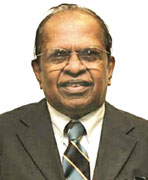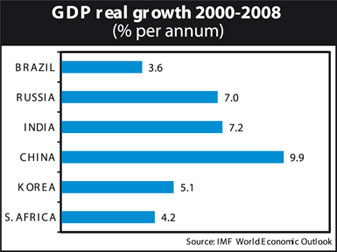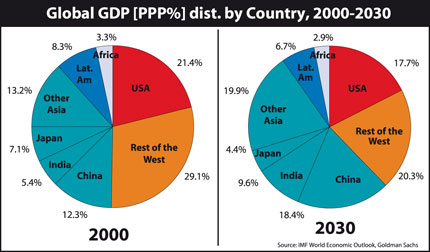BRICKS: Reshaping the new global economy
Dr. Dharma De Silva
 |
|
Dr. Dharma
De Silva |
The postulation of *BRICKS extends Goldman Sachs thesis of *BRIC
(Brazil, Russia, India and China) by adding Korea (K) and South Africa
(S), as emerging markets that are a growing force challenging the TRIAD
- anchored by Japan, USA, Germany (JUG) - dominance in the world trading
system.
Backed by BRICKS the global landscape, economic contours and
paradigms, are moving from an era of geographically concentrated
economic power to one characterized by multiple centers of economic and
business activity across cultures and continents.
The collective economic and trade dominance of the TRIAD is giving
way to a greater dispersal of competitive economic-trade-political power
among rapidly growing emerging markets of BRICKS.
At the same time they join TRIAD nations to share an ever-increasing
share of world output, trade, investment, mergers and acquisitions.
BRICKS then, join TRIAD's JUG to form a competitive fortress in the new
global economy.
Introduction
In this paper BRICKS thesis is postulated by adding Korea (K) an
industrial leader in electronics, ship-building and global trading and
South Africa (S), the economic force of the African continent, more than
as emerging markets in the classical sense, adding that they are a
'critical part of the new globalised economy' and just as central to its
functioning as of the G7 Group of developed nations.
BRICKS nations and TRIAD anchors Japan, Germany and USA are countries
primarily used in the economic, trade, financial as well as in academia
research spheres. These countries are forecast to encompass over 44
percent of the world's population and hold a combined GDP (PPP) of
nearly $18 trillion.
The study of BRICKS specifically focuses on the most populous
countries, and their combined economies, which are likely to be the
world's six most influential economies outside of the G7. In the debate
of reshaping the Global Economy, India and China are the two biggest
emerging markets, and are becoming the new engines of the global
economy.
 Economics apart, the term 'new world order' has been used also to
referred to a new period of history evidencing a dramatic change in
world political thought and the balance of power, and decisions at
multilateral negotiation that impact on business. One recent
illustration: Economics apart, the term 'new world order' has been used also to
referred to a new period of history evidencing a dramatic change in
world political thought and the balance of power, and decisions at
multilateral negotiation that impact on business. One recent
illustration:
The standoff between China and India, the world's two fastest growing
economies, and the United States not only buried the last attempt to
save the World Trade Organization Doha Round, but also demonstrated
changes in global governance and the balance of power in the 21st
Century.
BRIC Origin and BRICKS Enlargement
Beyond BRIC, the emergence of BRICKS countries in international
business has already begun to change the global economy in many ways, by
competitive markets, the use and cost of resources, and reallocation of
economic power. However, on almost every scale, BRICKS with TRIAD
anchors, JUG nations, would be the largest entity on the global stage
contributing to the new global economy and new world trade order, as
identified below, where:
1. The economies of the BRIC now in the 2000s and BRICKS next in the
2010s are rapidly developing and likely to accelerate faster and
gradually be able to eclipse most of the advanced economies dominated by
the TRIAD.
2. The economic potential of Brazil, Russia, India, China, Korea and
SAfrica [BRICKS] is such that they are predicted to be among the most
dominant economies as they approach 2050 benchmark established by
Goldman Sachs, Grant Thornton, Morgan Stanley and others.
3. These BRICKS countries have nearly 44 percent of the world's
population and hold a combined GDP (PPP) of about $18 trillion in 2008,
and estimated to be $28 trillion in 2015.
4. BRICKS are neither a political alliance, nor a global or regional
formal trading conglomerate but represent the key country of each
continent and are among the most populated nations with emerging
markets.
5. Goldman Sachs predicts China and India, respectively, to be the
dominant global suppliers of manufactured goods and business services
respectively while resource rich Brazil, Russia and SAfrica would be
similarly dominant as suppliers of raw materials and Korea remains an
industrial exporter.
6. Among the BRICKS, India has the potential to grow the fastest
during 2040-2050 years and a larger aging group.
7. Decline in working age population is in the horizon for India,
Brazil and Korea than for Russia, China and SAfrica.
8. In BRICKS the number of people with an annual income of over $9000
PPP will double within 5 years to reach 1 billion within a decade. That
means a massive rise in the size of the middle class
9. In 2025, it is calculated that the number of people earning over
$15,000 may reach over 2 billion.
10. By 2035, first China and a decade later India are expected to be
dominant players in the global economy along with US, followed by G-6
nations.
11. By 2025 the per capita income in the G6 will exceed $35000,
whereas only about 24 million people in the BRICKSs will have similar
income levels
12. The average wealth level of individuals in more advanced
economies of TRIAD will continue to outstrip the BRICKS average during
the 1st half of 21st C.
13. India's influence on the world economy will be bigger and quicker
than implied earlier by forecasters with the pre-eminent technological
advantage and domestic consumption orientation for economic growth.
 14. According to recent projections, China's economy will move ahead
of the US by 2027, India will catch up with the US by 2050 and the BRICs
(Brazil, Russia, India and China) as a group will surpass the G7 by
2032. 14. According to recent projections, China's economy will move ahead
of the US by 2027, India will catch up with the US by 2050 and the BRICs
(Brazil, Russia, India and China) as a group will surpass the G7 by
2032.
15. India has 10 of the 30 fastest-growing urban areas in the world,
and 700 million people are estimated to live in cities by 2050, adding
to the labourforce in key growth zones.
16. From 2010 to 2020 India's GDP per capita will quadruple, and the
Indian economy's sustained growth will meet the levels of the US by
2043.
17. China and Russia will expand their economies based on market
principles backed by trade reforms and liberalization but remain
centrally planned economies with state owned and operated enterprises in
banking, trading, telecommunications and energy.
18. BRICKS largest partners, India and China trade is a partnership
for success, resources' integration and Industry collaboration. As a
result India and China expected to be the driving forces behind the
global economic growth. For example vast potential for collaboration
between India and China's semiconductor industries, win-win situation
via successful partnerships
The writer is a Professor and Director, Centre for International
Business Advancement Chair, World Trade Council of Wichita, Barton
School of Business, Wichita State University
To be continued
|



